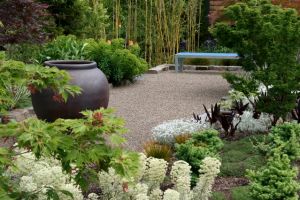Howdy!
We hope our last newsletter was helpful in your spring garden work. If you haven't checked in since then, we expanded on our spring cleaning theme with a little about gardening tools, ideas for growing food in busy lives and tough spaces, and tips for making a beautiful garden scene. Beyond those ideas, we've posted some neat photos, a winter post-mortem and more, so be sure to scroll through the journal when you're done.
In this newsletter, we'll discuss how we use color, texture and form to select and place plants in our gardens. The terms color, texture and form are used together so often in articles, books and lectures about planting design that they are almost cliche, but what do they mean for your planting design? Even a quick survey of online articles shows a huge variety of ideas for designing with those terms in mind. While one designer may prioritize flower color and structure, another focuses primarily on the texture and shape of leaves.
In our work, color, texture and form carry equal weight, and we have strong ideas about the best way to see and use each one. We select our plants to create a cohesive palette, sometimes subtle, sometimes high-contrast, that reflects the desired style and mood of the space. Because the possibilities are endless, and the results should reflect you and your aesthetic, we will focus on how we think about color, texture and form, leaving the nitty-gritty fun of building a palette to you.
Color
Foliage first - While flowers are fun and part of almost every garden, foliage color is the foundation of our plant color palette. We use foliage to create sweeps of color throughout the year, or at least the growing season. The colors vary from bold, contrasting spots of yellow and purple to accents of silver and burgundy to shades of green.
Know when to hold 'em - Even in a bold palette of strong, bright colors (restraint does not mean boring), restraint is key. We intentionally leave out some colors or save them for another area. If you love every color, or are the sort of person who can't leave a good plant at the nursery, try using different palettes in different areas of the garden. As you can see in the first photo, our front garden has lots of bright, hot color, while the side garden, at right, tends toward gentler pinks, blues, creams and whites.
What are we talking about here? - What we mean by "form" is the overall shape of a plant - upright, round, conical, weeping, arching, and so on. Sometimes form and texture overlap, as in spiky plants, like iris and Phormium, but for the most part, form has more to do with outline than texture.
Round, rounded, roundish - Every plant has a form, and some are stronger than others. Not all strong forms are geometric, but those are the easiest to discuss. For example, lots of plants have what we call a "roundish" form, where the outline more or less radiates around the center. Other plants have a more perfectly rounded outline. Picea sitchensis 'Papoose,' for instance, is almost spherical. A stronger form makes a stronger statement in the garden, and can be used as a structural, almost sculptural element in planting. We will shear some plants, like boxwoods and fine foliaged conifers, to tighten and perfect their form.
The dance - In many of our gardens, we select a plant with a strong form and "dance" three to seven of them through a layer of lower plantings. The repeating, usually evergreen, forms have room to shine, while the lower plantings add seasonal contrast and interest.
Another perspective
Not all designers think alike (thank goodness), and if you are seeking a different, nuanced, and perennial-savvy take on color form and texture, we highly recommend designing with plants by Piet Oudolf with Noel Kingsbury. Oudolf's sensitivity to tiny differences in, say, flower shape helps him create ever-changing, intricate, romantic plantings. What an inspiration....
That's all for now, folks! We'll be back over the coming weeks with more ideas and, everyone's favorite, new photos, so please check back soon.



